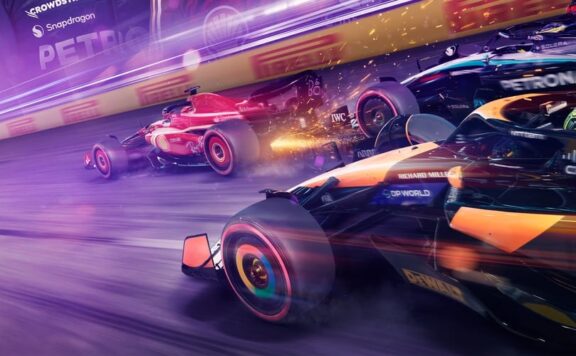When it launches in just over a month, F1 24 will bring with it a significant overhaul to the series’ physics and handling. Codemasters says that every year, granted, but this year they really mean it with a big year-on-year update that introduces new suspension kinematics, revamps the tyre model, adds rake to the aero model, puts more ERS control in the hands of the player, and more.
When most developers talk about suspension, it’s generally the necessary suspension of disbelief that a gamer needs to really invest themselves in a game’s narrative. For racing games, though, it’s all about the fragile-looking array of rods that connect the main body of a car with the rapidly rotating tyres that are (if everything’s going well) the only things touching the tarmac.
In many racing games, the suspension gets to hide underneath the bodywork of the vehicle, but once you get to an open wheel category like Formula 1, the suspension is there for everyone to see. F1 24 looks to capture all of that much better than the last few games with all-new suspension kinematics.
Senior Creative Directo Lee Mather said, “I always think one of the most obvious [real world example], it’s just a visual that stands out, is a car taking Eau Rouge. As it hits the bottom and the car’s compressed, you’ve got that massive compression and see the sparks, but then as they’re cresting over the top and onto the Kemmel Straight, you can see that significant movement in the suspension as they’re heading up the hill. You’ll often see that on TV in slo-mo, so you can really see there’s more travel than you probably expect there. That’s now something that’s pronounced in the game.”

This will be a complete and more dynamic simulation of an F1 (or F2) car’s suspension than before, capable of calculating dynamic camber and toe while driving, figuring anti-dive and anti-squat into the game’s model, letting heave and roll be handled individually, and using a more realistic centre of mass and inertia through this. The car’s rake also comes into this, with ride height and the aero benefits and compromises that it brings being a powerful tool for your car’s handling.
Combining all these new and overhauled factors, Codemasters aims to capture a lot of the real world car attributes that different teams have, in a more nuanced fashion than just the raw performance pecking order. It’s a constant discussion point surrounding the sport about how certain drivers prefer under or oversteer, how they want a twitchy front end or a solid rear, and how they have to harmonise with the car they’re given and the R&D path changing those elements – and inevitable suspicions that one driver’s preferences are being favoured over the other’s.
“When Casey built it, he took the data of the CAD models from each of the teams, and built them individually,” Lee told us. “So for players who are particularly deft with wheel and pedals, you’ll feel slightly different braking properties, because some of the cars are better with anti-dive than others. It’s built into the model.”
As the go-between from chassis to tyres, the suspension will feed into the revamped tyre model, with improved contact patch modelling, camber and slip angles to simulate the amount of grip the tyres can give you to the track, but also featuring a new thermal model. This will improve the game’s wear modelling, as it relates to both high and low temperature – racing in the wet and in cooler conditions will leave you with lower grip, in part because your tyres are cooler.

The final element here is with the power units as a whole. Engine braking is now a part of the car tuning, and players will now have access to more ERS modes while racing. Once again, it’s another step toward what drivers have to deal with in the real sport, juggling the need to use and harvest battery energy.
All of these changes have been led by a combination of Codemasters spotting areas to improve, as well as driver and team feedback, with brand ambassador Max Verstappen and the Mercedes team nudging them in certain areas.
“We can’t test against a knowledge of driving F1 cars,” Lee admitted, “which the drivers can, and also there’s a lot of intricacies that we would not have identified, because we can build a model, but can’t relate it identically to the real world. So while we can get a huge amount of data to work out if we’re building cars that are delivering lap times correctly, to work out the cornering speeds are correct, to understand more on the ERS deployment, the fuel usage – we can do all these things, but ultimately there’s very few drivers that have a great connection with sim racing and Formula 1. We’re very lucky that we do get access to Max, and his feedback is fantastic. He’s been giving us some great insight, not just for the here and now, but for the long term development of the sim and the tech, because he does play virtual F1 quite a lot in other capacities.
“We also work with Mercedes significantly as well. We have two relationships – one that caters to the esports side of things, and then the engineering side. We’re really lucky that we get an insight from the engineers at Mercedes into what they think we do well, what we need to adjust.”

Of course, Codemasters is very mindful about accessibility. There will still be car presets, and there’s a pro-squat bias to these to help newcomers, in tandem with the general accessibility of gamepad controls. Will all of this new depth and detail be overwhelming for newcomers, once you get past the basics, though?
“The goal is always to build a model which, at its core, can be driven by anyone and make you feel like a Formula 1 driver. Then we build into that the depth that players who want to play and engage at that level can understand,” Lee said.
“[For newcomers] one of the best things to do is try the extremes of the presets that we offer, find which direction feels better to you, and then go from there. We do put a lot of effort into the onboarding, so we do things like have the race engineer who will explain how things work – we’ve got a little bit more of that on the ERS this year, because it’s more complex.”
There’s plenty more to talk about with F1 24 in the run up to release. Keep an eye out later this week for a dive into new and improved game modes throughout F1 24, once again with input from Senior Creative Director Lee Mather.




